AI SEO Concepts Explained: What Marketers Need to Know About AI-Powered Search
How AI transformed search engine optimization: the fundamental shifts
Artificial intelligence is rewriting the rules of search engine optimization (SEO), making the playbook you’ve relied on for years obsolete.
You may have seen the widely-cited Gartner prediction that traditional search engine volume will drop by 25% by 2026. Current data shows that while search traffic has only dipped slightly, the use of AI tools like ChatGPT and Perplexity is growing fast.
This isn’t just another Google algorithm update. It’s a significant shift in how people access information. Users are transitioning from typing keywords into a search box to engaging in detailed conversations with these new “answer engines.”
If your SEO strategies only optimize for traditional search engine results pages (SERPs), it’s time to refine your content optimization strategy to account for the impact of AI.
This guide explains the new concepts you need to understand to adapt your digital marketing and meet your target audience where they are.
Let’s first look at the main search trends we’ve been noticing and AI impact on SEO.
From keyword-focused to intent-driven content
Traditional search engine optimization was built around keyword research.
You’d find relevant keywords with high search volume, optimize content, and the search engine algorithms would match a user’s search query to your page, ranking it in a list of blue links.
Your goal was to earn the click. Artificial intelligence has disrupted this model.
The machine learning models behind generative AI use natural language processing to understand context beyond simple text strings.
Instead of matching keywords to a list of links, they now synthesize information from multiple sources to provide a direct answer. They achieve this by understanding the true search intent behind a query, recognizing the entities involved (the real-world people, places, concepts, and brands your content is about), and their relationships.
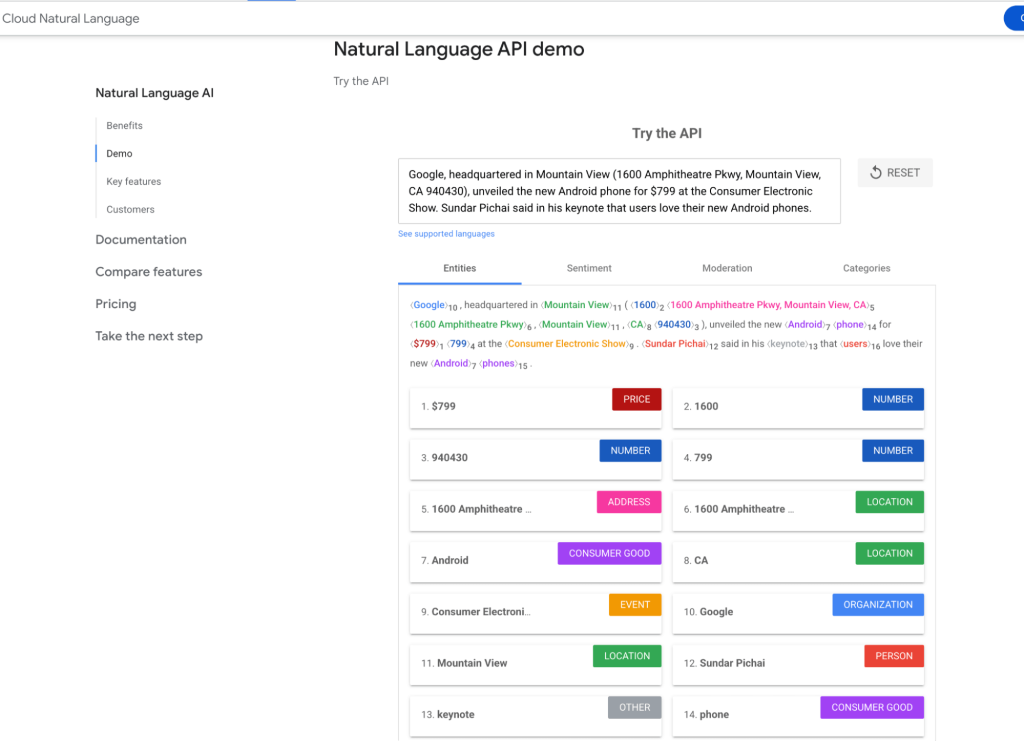
This means your primary goal shifted from earning a click to informing the AI’s generated response.
Example: A user asks, What's the best project management tool for a remote team that struggles with communication?
- Old SEO Output: A ranked list of links to “10 Best Project Management Tools” articles and sponsored pages.
- AI SEO Output: A synthesized overview of the top tools and quick mention citing the sources.

How does this change your SEO efforts?
- Genuine expertise matters: AI-powered tools prioritize high-quality, fresh, and in-depth content because it leads to more reliable answers. Strong internal linking between related pages also helps AI understand your topic authority.
- Structured data is a must: Adding schema markup to your website helps AI accurately identify the entities in your content, making it easier to use as a source.
- Comprehensive coverage wins: To inform the answer, your relevant content must fully address the user’s intent, not just touch on a keyword. This often means optimizing for conversational, long-tail keywords.
- Original insights add value: Unique perspectives are highly valued because they contribute new information to the AI’s knowledge base, beyond simply summarizing existing content.
A strong backlink profile was a direct path to higher search engine rankings, as these were considered a signal to measure authority.
Generative AI tools like ChatGPT and Claude don’t “crawl” your backlink profile to decide if you’re trustworthy. Instead, they look for broader, more holistic signals of brand authority across the web.
This means your focus must shift from acquiring links to building a reputable brand presence that AI algorithms can recognize and trust.
Example: Instead of focusing solely on getting a backlink from a tech blog, a B2B SaaS company might earn AI-era authority when:
- Its latest research report is discussed and cited (even without links) on industry forums and LinkedIn.
- Its CEO appears on a popular podcast, leading to conversations about the company on social media.
- A positive review on G2 is referenced by multiple users in a Reddit thread comparing solutions.
These organic signals of real-world relevance and expertise are what AI models are increasingly using to determine who to cite and recommend.
What’s changing in how you build authority?
- Brand mentions are the new backlinks: Unlinked mentions of your brand on reputable sites, forums, and social media are powerful trust signals for LLMs.
- Platform diversity is key: Authority is no longer determined by your website content alone. It’s built through LinkedIn articles, Reddit discussions, YouTube videos, and podcast appearances.
- User-generated content as proof: Reviews, forum discussions, and social media conversations are factored in as real-world evidence of your brand’s reputation and user experience.
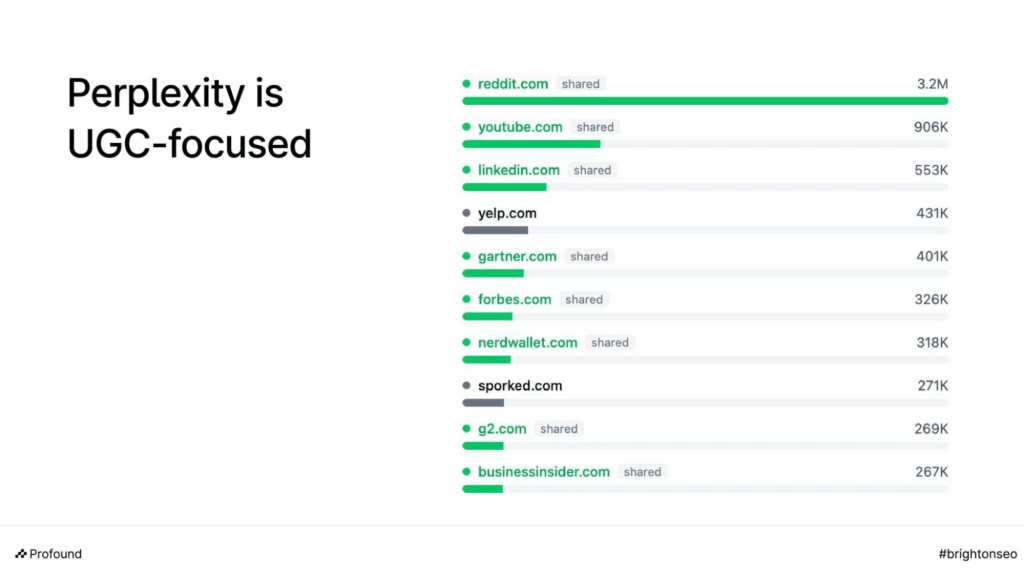
- PR and thought leadership: Earning mentions in trade publications or contributing to expert roundups creates high-value authority signals even when those pages don’t link back to your website.
The changing user journey: from blue links to a blended UI
The goal of search engine optimization is no longer just to win a spot in the ten blue links. Google search results page is embracing AI, pushing traditional results further down the page, making them just one component of a much more complex SERP.
This means features like “People Also Ask,” featured snippets, and AI Overviews are designed to provide answers directly on the results page.
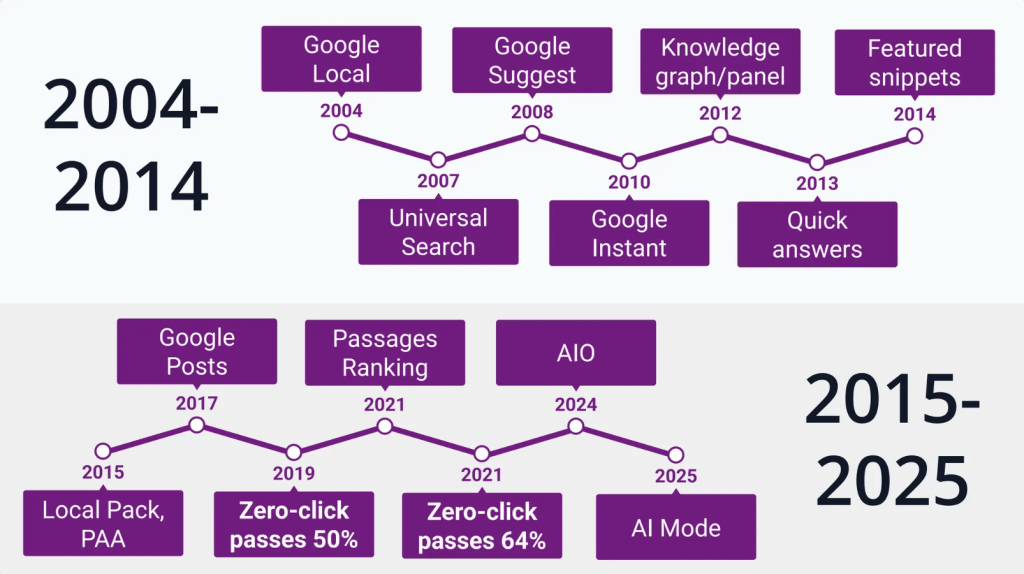
Additionally, Google has just launched its new “AI mode”, a fully conversational interface that directly competes with AI tools like ChatGPT, making the classic list of links a secondary feature. This is a clear indication that the search experience is favoring AI answers.
Example: A search for what's the best tool for tracking AI traffic no longer just returns a list of links. Instead, Google’s AI Overview dominates the top of the page, providing a direct, synthesized answer. As you can see below, the traditional blue links are pushed far down the page, and the user’s initial query is often answered without a single click.
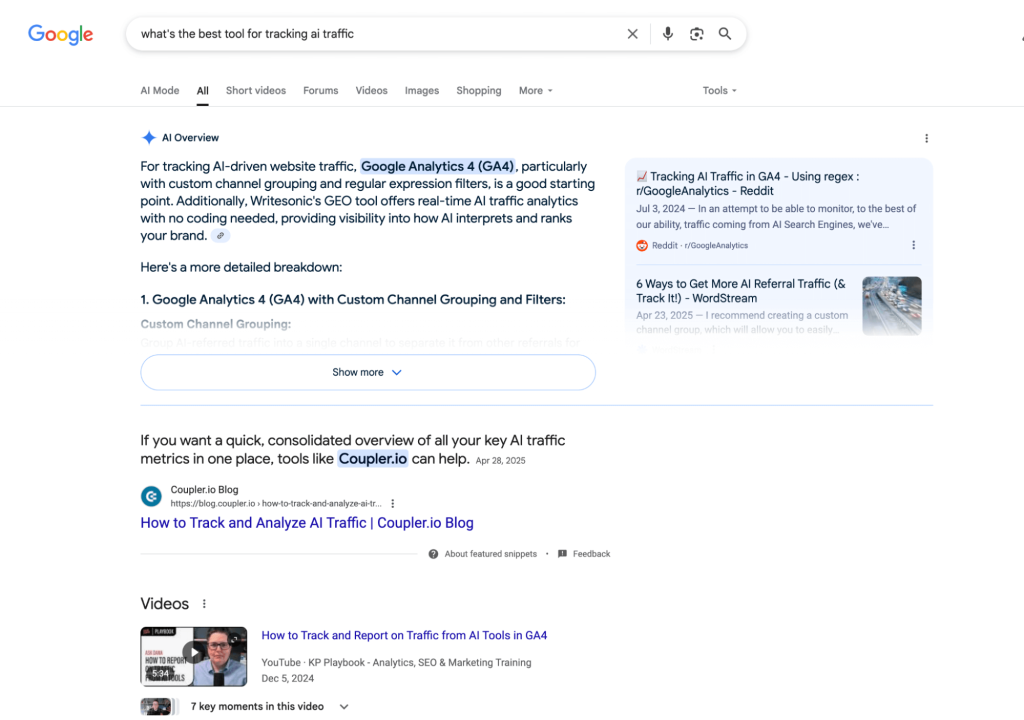
New patterns to pay attention to:
- Conversational search within Google: Users are beginning to use Google’s new AI mode to ask detailed follow-up questions, exploring topics without needing to leave the search interface.
- Answer-first SERPs: Google’s AI Overviews and other features often provide a complete answer, leading to more “zero-click” searches where users don’t need to visit your web pages.
- Alternative discovery engines: As users get accustomed to answer-first experiences, many are starting their journeys directly in AI tools like Claude or Perplexity, bypassing Google entirely for specific queries.
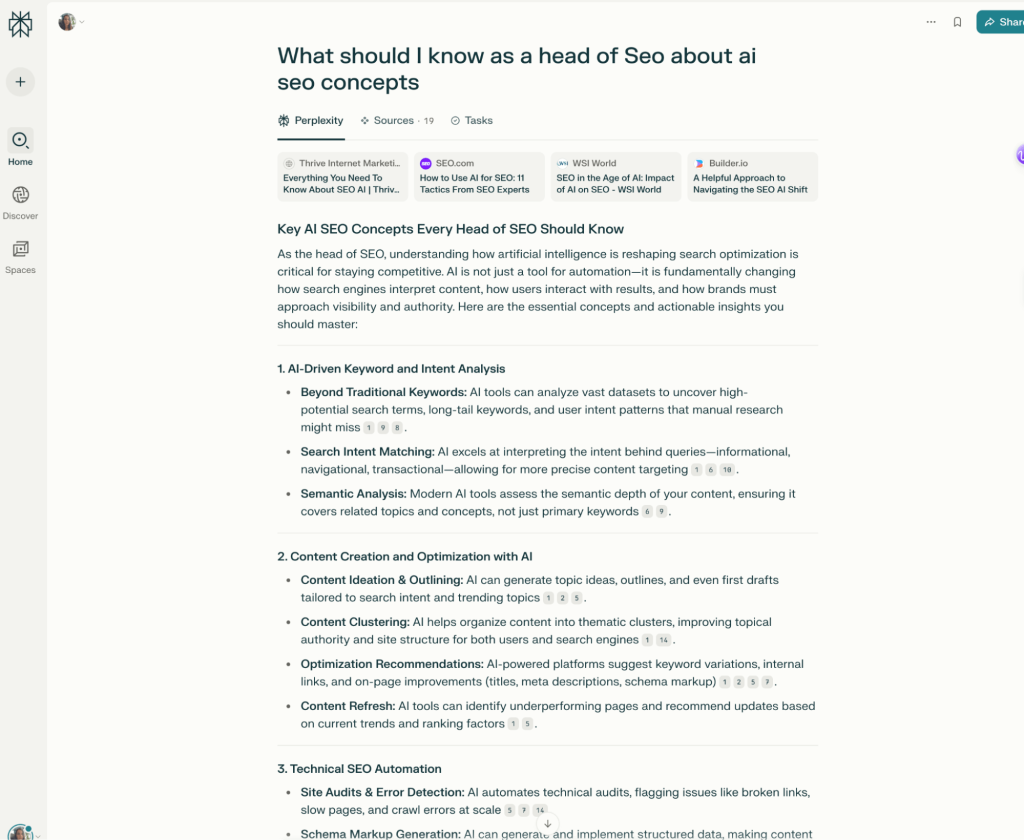
- Social platform search: For product discovery and “how-to” content, channels like TikTok, LinkedIn, and YouTube are becoming primary search engines, further fragmenting the user journey.
These shifts require a new playbook.
For a step-by-step guide on how to adapt your strategy and get more organic traffic from AI search, see our complete 8-step guide on how to get traffic from AI.
Understanding the new lingo of AI search
The shift to AI search has introduced new acronyms that might sound confusing at first. While they describe overlapping concepts, understanding the distinctions is key to building a comprehensive AI for SEO strategy.
We’ll break them down into two main categories.
SEO optimization for AI generative tools
This category covers all optimization efforts aimed at influencing the answers provided by text-based generative AI models. This is the core of modern AI-powered SEO.
GEO (Generative Engine Optimization)
GEO is the umbrella term for content optimization for AI. It’s a comprehensive content strategy for optimizing your content and brand authority across all AI-powered search engines, including ChatGPT, Perplexity, Claude, and Google’s AIOs, as well as Google’s recently introduced AI mode.
Industry experts sometimes refer to this holistic approach as “Search Everywhere Optimization,” as it goes beyond a single platform.
| GEO Focus | Making your high-quality content easily discoverable, parsable, and trustworthy for a wide variety of LLMs. |
|---|---|
| GEO Key Tactics | Building brand authority across multiple platforms, demonstrating expertise through in-depth content, and ensuring your technical SEO is sound. |
| The Goal | To become a primary, citable source that AI models use to construct their answers. |
AIO (AI Overviews)
AIO refers specifically to optimizing for Google’s AI Overviews, the AI-generated summaries that appear at the top of Google’s SERPs. Think of it as a specialized subset of GEO. While the principles are similar, AIO are generated by AI behind Google’s search engine algorithms.
| AIO Focus | Getting your content cited within Google’s generative answers for valuable search queries. |
|---|---|
| AIO Key Tactics | Strong E-E-A-T signals, well-structured content using schema markup, and a solid foundation in traditional SEO. |
| The Goal | To achieve visibility and earn citations in the most prominent AI feature on the web, directly influencing users at the top of the funnel. |
SGE (Search Generative Experience)
SGE is a historical term. It was the public brand name for Google’s initial AI search experiment that has since evolved into today’s AI Overviews. You don’t need to optimize for “SGE,” but understanding its history provides context for Google’s long-term commitment to generative AI in search.
SEO optimization for AI voice assistants
This is a distinct yet related field whose principles have become increasingly relevant in the era of artificial intelligence.
VEO (Voice Engine Optimization)
VEO is the practice of optimizing content for voice assistants, such as Alexa, Siri, and Google Assistant. Voice search behavior uses natural, conversational language, which is a direct precursor to how users interact with modern AI chatbots.
| VEO Focus | Answering specific, question-based queries in a concise and direct manner. |
|---|---|
| VEO Key Tactics | Optimizing for featured snippets (which voice assistants often read aloud), targeting long-tail keywords formatted as questions, and having strong local SEO signals for “near me” type queries. |
| Relevance to GEO | The skills required for VEO—understanding conversational user intent and structuring content into clear answers—are now essential for all forms of AI-powered SEO. |
While the acronyms and platforms differ, they all point to the same strategic shift.
SEO success is no longer about mastering keyword density, but about demonstrating genuine expertise through well-structured, authoritative, and helpful content.
Understanding these concepts is the first step, but putting them into practice requires a new approach to tracking and measurement.
Why AI SEO is challenging (as of July 2025)
There are two primary challenges you should be aware of before developing an effective marketing strategy for AI content optimization.
The absence of clear rules and predictable algorithms
Traditional SEO had relatively clear guidelines, thanks to Google’s documentation and years of testing. AI search, however, looks more like a black box.
AI algorithms are non-deterministic, meaning the same prompt can generate different results at different times.
On top of that, the decision-making processes of LLMs are largely opaque, and the platforms continually update their models without warning.
This means you can’t “game” the system. The only future-proof strategy is to focus on content quality rather than trying to reverse-engineer a specific algorithm.
The challenges in tracking and measuring AI traffic
The unpredictability of AI tools leads to a measurement challenge. If the system you’re trying to influence is always changing and provides no clear rules, what exactly do you track?
Key AI visibility measurement challenges:
- Prompts are not keywords: You can’t track traditional metrics like search volume for specific prompts because AI responses change constantly, making manual monitoring time-consuming. A prompt that cites you today might not tomorrow.
- Attribution is broken: AI tools rarely pass referral data, meaning valuable traffic is often misclassified as “Direct,” making it impossible to tie conversions to specific AI interactions.
- No standardized metrics exist: There is no “AI rank” or single performance indicator. Visibility is now a complex mix of direct citations, unlinked brand mentions, sentiment, and referral traffic.
These challenges don’t mean you’re flying blind, but they do require a completely new approach for measuring success. It’s no longer about which keywords generate traffic; you should look at AI citations and overall brand authority across AI-driven search answers.
Let’s explore what this looks like in practice.
The 2-part framework for tracking AI visibility with AI SEO tools
To get a clear picture of your performance, you need a blended approach.
Here is a simple 2-step framework combining automated tracking with qualitative analysis and the AI SEO tools you can use right away.
Step 1: Monitor referral AI traffic (the clicks)
This is about tracking users who click a link from an AI tool and land on your website. Since this traffic is often misattributed in standard SEO analytics, the most effective solution is an automated dashboard that connects directly to your Google Analytics 4 data.
This pre-built AI traffic dashboard, powered by Coupler.io, does exactly that. It automatically pulls, cleans, and visualizes your AI referral data, transforming a complex measurement problem into a clear and actionable overview.
AI traffic performance dashboard
AI traffic performance dashboard
Preview dashboardInstead of just listing generic traffic sources, this dashboard offers in-depth, business-focused insights. With it, you can:
- Identify your top AI traffic sources: See a clear breakdown of which AI platforms, such as ChatGPT, Copilot, or Perplexity, are driving the most users to your site. You can instantly see who your biggest AI referrers are.
- Connect AI traffic to business results: Analyze the direct impact on your bottom line by tracking the purchase revenue and total number of conversions generated by each specific AI source.
- Visualize performance trends: Use the built-in time-series charts to visually monitor trends in users, sessions, and purchases. This makes it easy to spot traffic spikes and correlate them with your marketing efforts.
- Discover your most valuable AI-driven content: Pinpoint exactly which articles, blog posts, or product pages receive the most AI traffic and analyze their engagement metrics to understand what type of content resonates most with this high-intent audience.

For a detailed walkthrough on configuring GA4 and building your own tracking system, check out our complete guide on how to track and analyze website traffic from AI sources.
Step 2: Monitor AI mentions (the citations)
This is about seeing when your brand is mentioned within AI responses, even without a click. These citations and brand mentions are leading indicators of your authority and potential AI traffic.
This requires a different set of tools.
We can group them into two main categories: established SEO platforms that are incorporating AI features, and new, AI-first solutions designed specifically for this purpose.
Established SEO platforms with AI tracking features
These are the tools you likely already use. They are expanding their feature sets to include visibility in Google’s AI-powered SERP.
- Ahrefs: A leader in this space, the tool allows you to track your site’s visibility and citations within Google’s AI Overviews. You can see which of your target keywords trigger an AI Overview by filtering the organic keyword reports.

For mor advanced insights, you can use the Brand Radar feature, which comes at an extra cost.
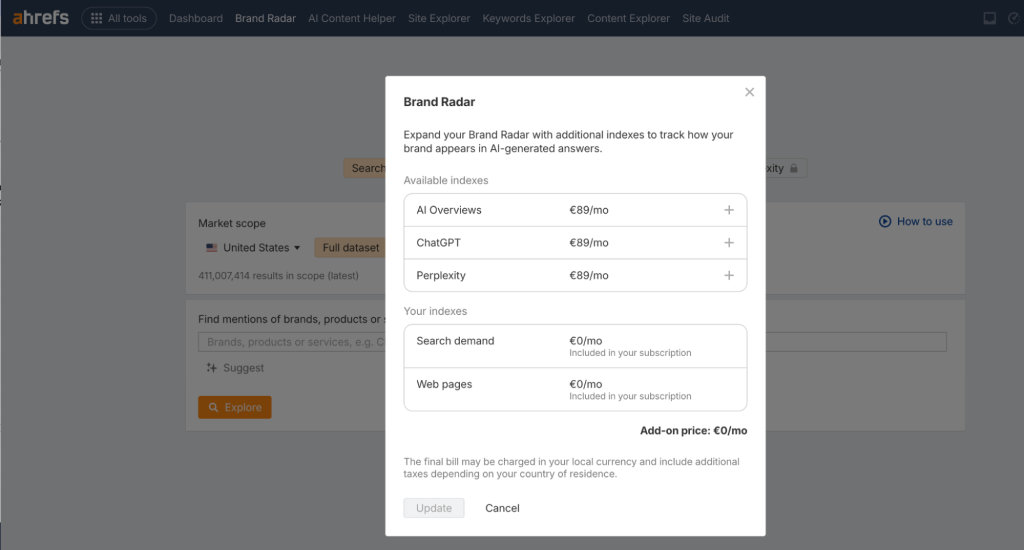
AI-first solutions for multi-platform prompt monitoring
These new tools are built from the ground up to track your brand’s presence across multiple LLMs, not just Google. They answer the question, “What is ChatGPT, Claude, and Perplexity saying about me?”
- Peec AI: This platform excels at multi-model tracking, monitoring your brand’s visibility and citations across ChatGPT, Perplexity, and Google AI Overviews. Its strength lies in source analysis, showing you which specific sources the AI is using to form its opinion about your brand or your competitors.
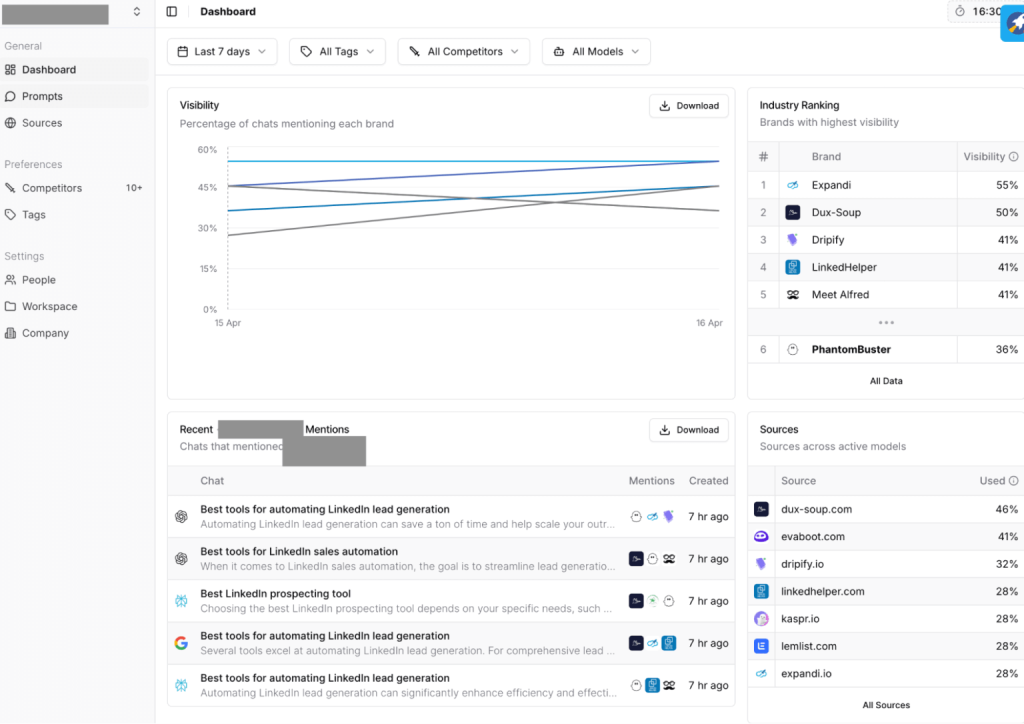
- Otterly AI: Otterly focuses on prompt-level monitoring and provides “answer snapshots” to show you exactly how your brand is being portrayed across different AI platforms. It’s particularly useful for tracking sentiment and share of voice in specific conversational contexts.
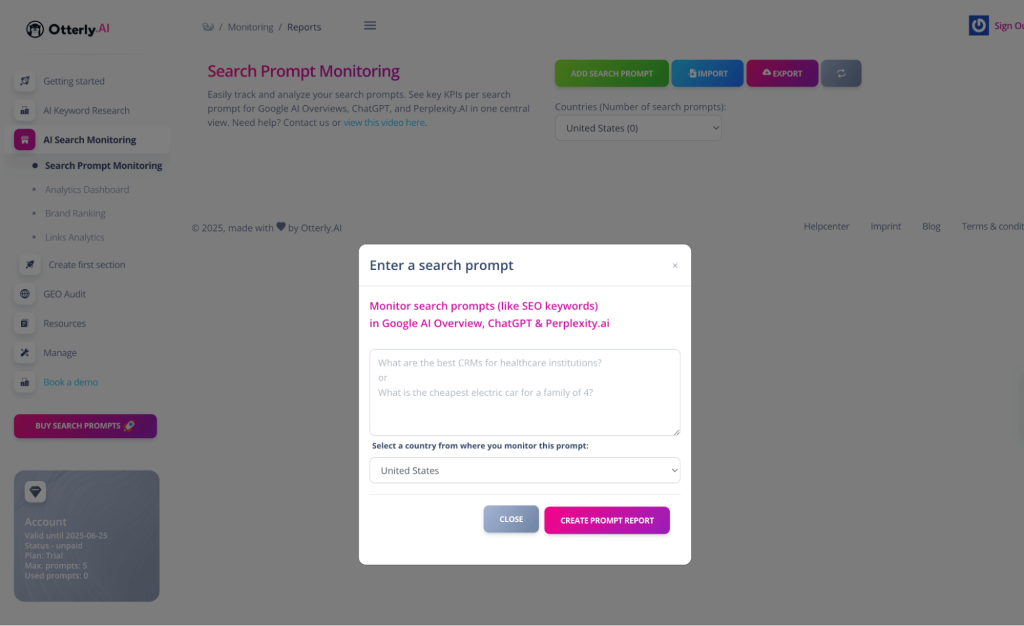
Free alternative for small projects: Manual spot-checking
For smaller projects with limited budgets, manual spot-checking provides a cost-effective way to understand your AI visibility without investing in automated tools. However, this approach becomes time-intensive and impractical for larger projects due to the manual effort required.
This hands-on process helps you understand the context, sentiment, and accuracy of how your brand is being represented across different AI platforms.
| Best for | Small businesses, startups, or companies just getting started with AI SEO who want to understand the basics before investing in automated solutions. |
| Limitations | Small businesses, startups, or companies just getting started with AI SEO, who want to understand the basics before investing in automated solutions. |
Here’s how to structure your manual testing for maximum insight:
Create a core prompt library
Don’t just ask random questions. Develop a library of 15-20 core prompts that represent your most valuable use cases, customer pain points, and competitive comparisons.
- Informational prompts: “What is [your core concept]?” or “How do I solve [customer problem]?”
- Comparative prompts: “[Your Brand] vs. [Competitor]” or “Best tools for [your category].”
- Branded prompts: “Is [Your Brand] good for [specific use case]?”
Implement a weekly testing routine
Dedicate time each week to run a subset of your prompt library through the most important platforms for your business (e.g., ChatGPT, Perplexity, and Google’s AI mode).
- Document everything: Use a simple spreadsheet to track the date, platform, prompt, and the AI’s response. Note whether your brand was mentioned, the context of the mention (positive, negative, neutral), and which sources were cited.
- Use incognito mode or a VPN: For Google’s AI Overviews, always use an incognito or private browser window to ensure results aren’t biased by your personal search history. Using a VPN will let you test SERP results across your target audience’s location.
Analyze the qualitative data
This is where the real value lies. Review your weekly findings and ask critical questions:
- Is the information accurate? If an AI is misrepresenting your product based on an old review, it’s a signal to generate new, positive user-generated content.
- Who are the cited sources? If a competitor is consistently cited, analyze their content to identify what they’re doing right. Are their pages better structured? Is their expertise clearer?
- What is the sentiment? If you’re mentioned negatively, trace it back to the source. It could be a single influential Reddit thread or an outdated article that needs to be addressed through digital PR or new content creation.
This manual approach provides qualitative insights that can inform your overall content strategy. At the same time, remember that automated tools offer the scalability and comprehensive coverage needed for serious AI SEO efforts..
When to upgrade: If you find yourself spending more than 5-10 hours per week on manual testing, or if you need to track more than 50 prompts regularly, it’s time to invest in automated AI SEO tools for better efficiency and comprehensive coverage.
Frequently asked questions (FAQs)
Should I stop traditional SEO and only focus on AI optimization?
No, you should expand your strategy, not replace it. Strong traditional SEO fundamentals like technical SEO, user experience, and high-quality content are the foundation that AI-powered SEO is built upon. AI Overviews and other generative models often cite well-optimized, authoritative pages that already rank well in traditional search.
What’s the single most important factor for ranking in AI answers?
There is no single factor, but the closest thing is demonstrated brand authority. AI models prioritize trust and expertise. They determine this by synthesizing signals from across the web, including expert-led content on your site, positive user-generated content (like reviews), and brand mentions on reputable third-party platforms.




